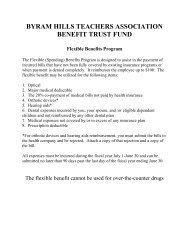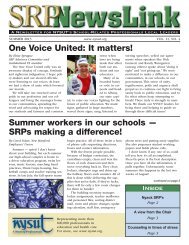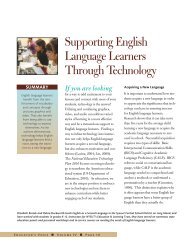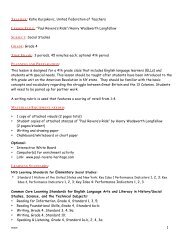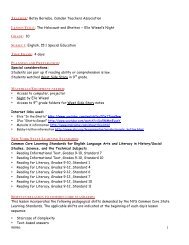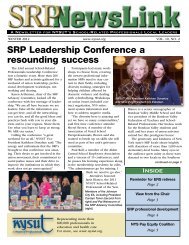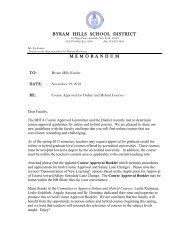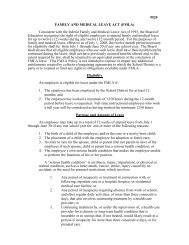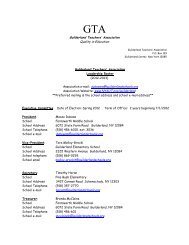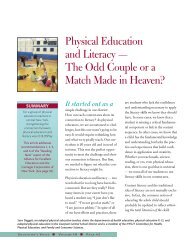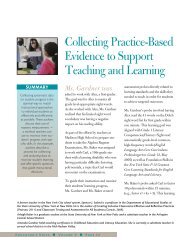Functional Literacy in a Life Skills Curriculum - NYSUT
Functional Literacy in a Life Skills Curriculum - NYSUT
Functional Literacy in a Life Skills Curriculum - NYSUT
Create successful ePaper yourself
Turn your PDF publications into a flip-book with our unique Google optimized e-Paper software.
Ashli Dreher, Lewiston-Porter United Teachers<br />
research <strong>in</strong> the area of teach<strong>in</strong>g phonics<br />
to students with DS and its relationship<br />
to their acquisition of literacy<br />
(Fowler, Doherty, & Boynton, 1995;<br />
Buckley, Bird, & Byrne, 1996;<br />
Cupples & Ianco, 2000; Conners,<br />
1992; Fletcher & Buckley, 2002;<br />
Joseph & Seery, 2004). Although all<br />
<strong>in</strong>dividuals with Down syndrome<br />
experience cognitive delays, the<br />
delays range from mild to moderate <strong>in</strong><br />
severity. This article will focus on<br />
<strong>in</strong>structional strategies for students<br />
with a moderate developmental delay.<br />
Teach<strong>in</strong>g students with moderate<br />
developmental disabilities to read was<br />
a challeng<strong>in</strong>g task to look forward to<br />
when I began the 2003 school year. As<br />
I met my first group of eager freshman<br />
<strong>in</strong> Lewiston-Porter High School’s new<br />
8:1:1 (eight students, one teacher, and<br />
one teacher aide or teach<strong>in</strong>g assistant)<br />
life skills classroom, all but one of the<br />
students could read little more than<br />
their own name when they walked<br />
<strong>in</strong>to school on the first day of classes.<br />
Dur<strong>in</strong>g the next six school years, however,<br />
five of the six students with<br />
Down syndrome and moderate mental<br />
retardation learned to read and write<br />
at the first-through-third-grade levels.<br />
A comb<strong>in</strong>ed approach utiliz<strong>in</strong>g systematic<br />
phonics <strong>in</strong>struction and a language<br />
arts life-skills-based curriculum provided<br />
the students with the understand<strong>in</strong>g<br />
of the sounds <strong>in</strong> our language as well as<br />
common sight words they would see <strong>in</strong><br />
restaurant-related jobs, at home when<br />
cook<strong>in</strong>g <strong>in</strong> the kitchen, or on packages<br />
at the grocery store. The phonemic<br />
awareness <strong>in</strong>struction occurred three<br />
times each week as whole group lessons,<br />
and <strong>in</strong>struction was differentiated<br />
based on a student’s ability to recognize<br />
letters and sounds. The different ability<br />
groups were <strong>in</strong>structed simultaneously.<br />
PowerPo<strong>in</strong>t slides shown <strong>in</strong> Table 1<br />
were developed to target Level 1 and<br />
Level 2 dur<strong>in</strong>g the lesson, and teacher<br />
aides provided one-to-one assistance to<br />
students work<strong>in</strong>g <strong>in</strong> Level 1. Level 1 of<br />
the phonics program <strong>in</strong>volved construct<strong>in</strong>g<br />
three-letter words with short<br />
vowel sounds, such as cat, cot, cut, tip,<br />
etc. Level 2 students construct threeand<br />
four-letter words with short vowel<br />
sounds, digraph blends (ship, shop,<br />
chip, chop), and blends (flop, flat, flip)<br />
as well as words with welded sounds<br />
(s<strong>in</strong>k, sank, sunk). Level 3 students<br />
beg<strong>in</strong> to learn how to sound out multisyllabic<br />
words conta<strong>in</strong><strong>in</strong>g short vowel<br />
cont<strong>in</strong>ued on follow<strong>in</strong>g page<br />
METHODOLOGY<br />
Do I have to teach<br />
them how to read<br />
Every middle and high<br />
school has some students<br />
who have not yet mastered<br />
the basics of read<strong>in</strong>g. They<br />
may be English language<br />
learners, students with<br />
cognitive disabilities, or<br />
students with bra<strong>in</strong> <strong>in</strong>juries.<br />
These students may receive<br />
support <strong>in</strong> a resource room,<br />
through Academic<br />
Intervention Services, or <strong>in</strong><br />
special education.<br />
But when they are <strong>in</strong> a<br />
regular classroom they may<br />
need assistance with<br />
vocabulary. While the<br />
strategies outl<strong>in</strong>ed here<br />
appear to be for elementaryage<br />
beg<strong>in</strong>n<strong>in</strong>g readers, you<br />
will f<strong>in</strong>d students at this<br />
read<strong>in</strong>g level <strong>in</strong> many<br />
content classrooms.<br />
E D U C A T O R ’ S V O I C E n



